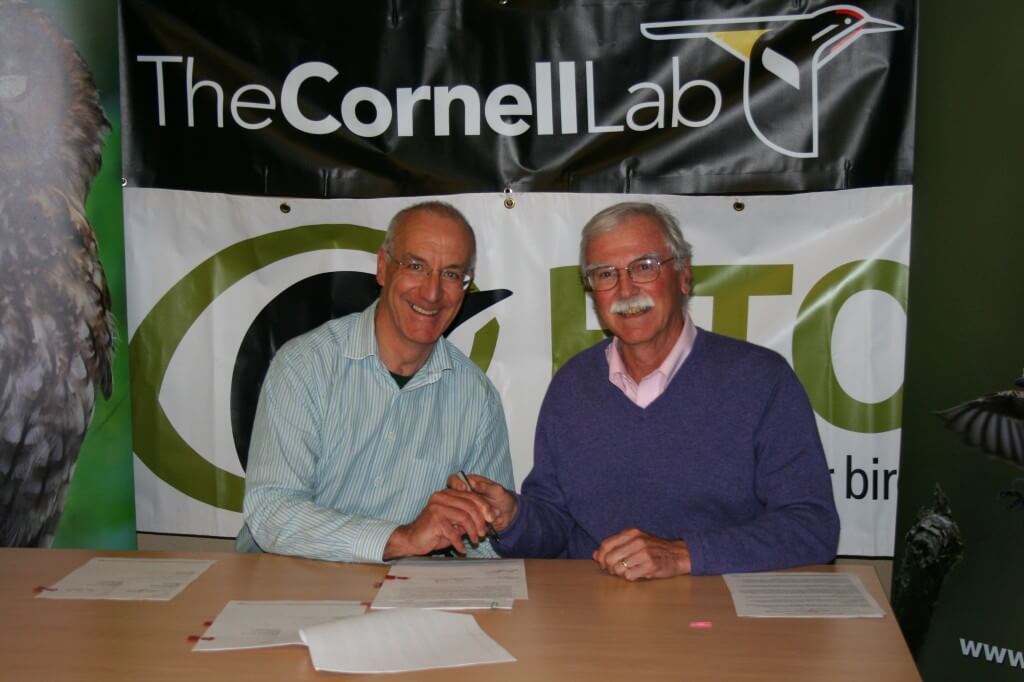
BTO recently hosted a visit from the Cornell Lab of Ornithology (CLO), Ithaca, NY, USA marking the exciting culmination of a year’s discussions to set up a long-term collaboration between our two organisations. It is thanks to Mark for initiating contact between myself and John Fitzpatrick, CEO at Cornell Lab, following Mark’s US road trip a couple of years ago, and it has seemed like a natural step for us to get together. CLO and BTO have many common interests and complementary expertise in ornithological research and survey work. A new Memorandum of Understanding signed here at BTO provides the foundations for a programme of joint work that will maximise our contributions to ornithological research and conservation science.
The first phase of our collaboration will involve the development of a global repository for the sharing, visualisation and analysis of observational data on birds. BTO and CLO have, to date, independently developed successful web-enabled bird checklist programmes, BirdTrack and eBird, that between them engage networks of tens of thousands of birdwatchers. Each organisation has expertise in avian ecology, ecological modelling and information science. As part of our collaboration, and because the migratory movements of birds are global and do not respect geographical or political boundaries, we recognise the need for closer international collaboration involving web-enabled bird checklist programs and other observational data on avian distributions and abundances. To this end, our formal collaboration aims to produce high quality ecological research addressing key conservation issues at continental and global scales, and to enable birdwatchers and scientists throughout the world to access, explore, analyse, visualise and interpret these pooled observations.
The power of large scale bird checklist data, coupled with today’s sophisticated analytical, modelling and visualisation techniques, brings new insights to understanding bird populations and their movements in the context of environmental change. This eBird visualisation of Orchard Oriole breeding distribution – part of an animated map of its summer movements into the USA – demonstrates for the first time the clear separation into two populations either side of the Ozarks.
This pattern of observations (proportion of complete lists) for Stonechat in Britain and Ireland from BirdTrack highlights a significant reduction in detection during the severe winter of 2010–11. This provides fascinating context for the results of Bird Atlas 2007–11, which indicate a large winter range expansion for this species.
BTO and CLO recognise that our collaboration is only part of a wider effort that will be needed to achieve our aim for more comprehensive and accessible data across the globe. There are many existing schemes for capturing bird observations at national, regional and international scales. Thus it is the creation of a shared, global repository of data from these schemes, rather than creation of new data collection initiatives, that is now the highest priority for realizing the potential of the information that is being collected. We hope many partners will see the benefit of a single repository for global bird observations, and work with us to create the most comprehensive data repository possible. To this end, to date we have discussed our vision with organisations including Birdlife International, RSPB and, for BTO, our key European partners particularly through the European Bird Census Council (EBCC).
If you are an eBird user or a BirdTrack user, please continue to contribute observations as you have been doing, assured in the knowledge that we are working together to bring these data into a common repository, enabling the data to make a greater difference for birds at a global scale. I guess Mark will be moving from his active BirdTrack-ing in the UK, to eBird-ing on his next US trip in a couple of weeks time – a great ambassador for wanting to make his birding count at any scale!
[registration_form]
Extremely interesting and a final prompt that persuades me that I must start routinely contributing to BirdTrack. A great initiative too! Well done all!
On a flippant note, ” Mark’s road trip to the US” . Now, I shall forever see you as the Jack Kerouac of the ornithological world.
Jack Kerouac? Well it will be a memorable trip if that’s the model!
On the other hand if Hunter S Thompson is the model he might not remember it at all!
Jonathan – I’m in fear and loathing of Las Vegas
I have learnt so much since I started my ringing training with the BTO and using Bird Track. I have seen ringed birds migrate and return to the same patch the following year and even the same nests, it’s amazing. And all this information can be shared to help protect birds in the future.
The BTO have been able to put 5g tags on cuckoos to track their movements and it makes me wonder what technology will be able to do as I get older.
Really great to see, as a member of both organisations! (who should use both BirdTrack – and E-Bird for the 2-4 weeks a year I’m in the US – a lot more often)
The eBird visualisations are just fantastic, beautifully produced. It would be great to see similar mapping for Europe, not just the UK, using the sort of global repository you’ve been discussing. Exciting times.